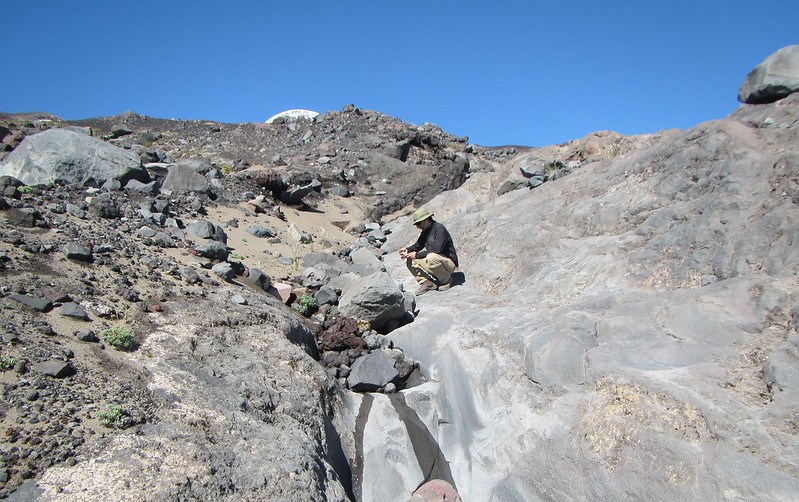
25 Mar Carlos Castelli and Francisco Camus, geologists: “Some people say that mining in Chile is already mature, the reality is that it is not the case. There’s still a lot to explore”
Castelli and Camus have recently launched the book “History, exploration and geology of Chile´s metal deposits”. This true bible of exploration reflects their knowledge and experiences, and puts a new paradigm in geology to the test, which could lay the foundations for new tools that will allow findings and work on new deposits.
According to data from Cochilco, mining exploration budgets in Chile in 2021 reached US$548 million, growing 19.6% compared to 2020, where US$458 million were invested. Although this is positive news for the industry, the truth is that fewer companies are carrying out explorations in the country, falling one position in the world ranking promoted by the consulting firm S&P, leaving our country behind Mexico in Latin America.
Due to the economic recovery that has been registered in recent months and the increase in the price of commodities such as copper, the worldwide exploration budget amounted to US$11,243 million in 2021, which represents an increase of 35% compared to with 2020, installing an auspicious panorama for the industry, which will be analyzed during the next Mining Exploration Forum during Cesco Week 2022, on March 28th, at the Intercontinental Hotel.
But finding new deposits is not based on random events. Years of study and sharing knowledge among peers are required to find mineral deposits that are attractive for the development of a mining project.
For decades, two geologists, Francisco Camus and Juan Carlos Castelli, conceived the idea of a book that reflected their knowledge and experiences. Despite the years of giving the idea some thought, four years were enough for the development of ten chapters and a key question: What happens below those two kilometers of the Earth that we already know? In this way, the sum of the information collection on deposits in Chile, a review of the mining history of the country, and a series of data that arose from the research that supports this new paradigm, presented by two experienced geologists, gave the result of a book that contains a complete updated geological observation and description of the country’s metal deposits. A true bible of geology in Chile.
The authors’ vision
-What is it that makes this book so different from the rest that have been written about geology in Chile?
There are few comprehensive books, but there are many international publications.There are highly trained geologists in this country, they have done tremendous work on a deposit or a strip or a prospect in magazines of planetary caliber, but a book that summarizes the history of mining in Chile does not exist. If you are looking for an up-to-date book on mining in Chile, you will probably find information from the 1960s, because the last book as a compendium of the entire industry dates from those years, at a time when the country had only six mines: a couple of iron mines and four copper mines. There were no gold mines. Until approximately 1975, this was the cadastre.
But then, between 1976 and 2015 there were 132 deposits, of which more than 70 are in production. The picture is quite different. The spectrum was opened to us in an impressive way, and the added knowledge is also impressive, but this is not summarized anywhere.
-What was the question that started the book “History, exploration and geology of Chile´s metal deposits “?
The deposits are a set of chemical and physical processes that occur in nature and are generally associated with the first two kilometers of the crust from the surface. What happens below? Where do they come from? That was what started our work.
-What need does this work respond to?
A new tool is missing, a new paradigm for the next stage. Some people say that “mining in Chile is mature”, and the reality is that this is not the case, there is still much to be explored. The people who make that comment are the mature ones. One cannot believe that Chile does not have more resources. A new key will appear and more deposits will appear along with it. This happened with satellite images, which made it possible to locate several deposits, until those that were detectable through that tool ran out, this is what happens with each technological advance. That is why at this moment, ideas are what’s missing.
With the experience we have, with the things we have seen, we have different ideas and we are proposing them. In this book we explore some ideas that we are applying in several places and they are working. These ideas will probably be the “1.0 version” in the future. This is not the final result, this is going to be taken by people and they are going to refine it, they will make a more sophisticated product. This could be the first bike, which has been improved, if you compare what we have today to the first bike, you can see the long road they had to make to get to where we are now.
-Why do you think there are not many registrations of the knowledge that has been accumulated ?
Geology is a science that started very late in the history of mankind. Unlike many other sciences such as biology, mathematics and physics. Geology starts at the end because it is much more complex, it needs the bases of biology, physics, chemistry and mathematics.
This causes paradigms to be built and broken all the time. Every time new data appears, new conclusions emerge. So, from that perspective, we compiled all the information that was not in the books, information we collected with the mining companies, and analyzed it in a single book.
